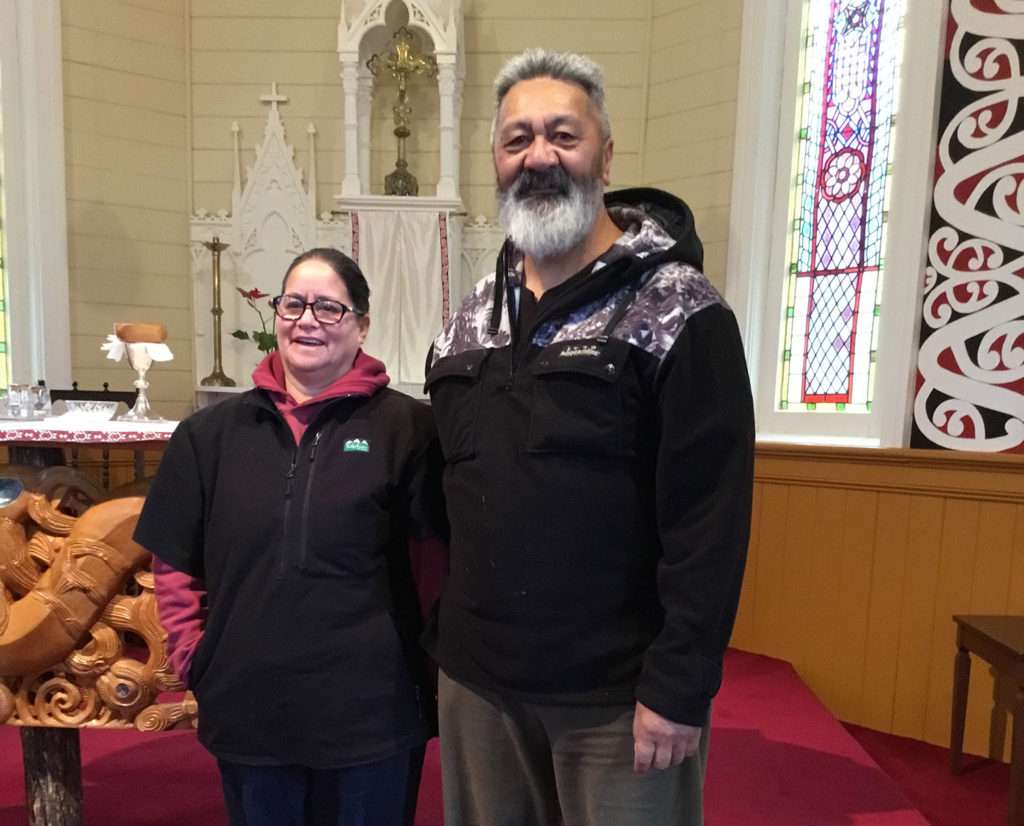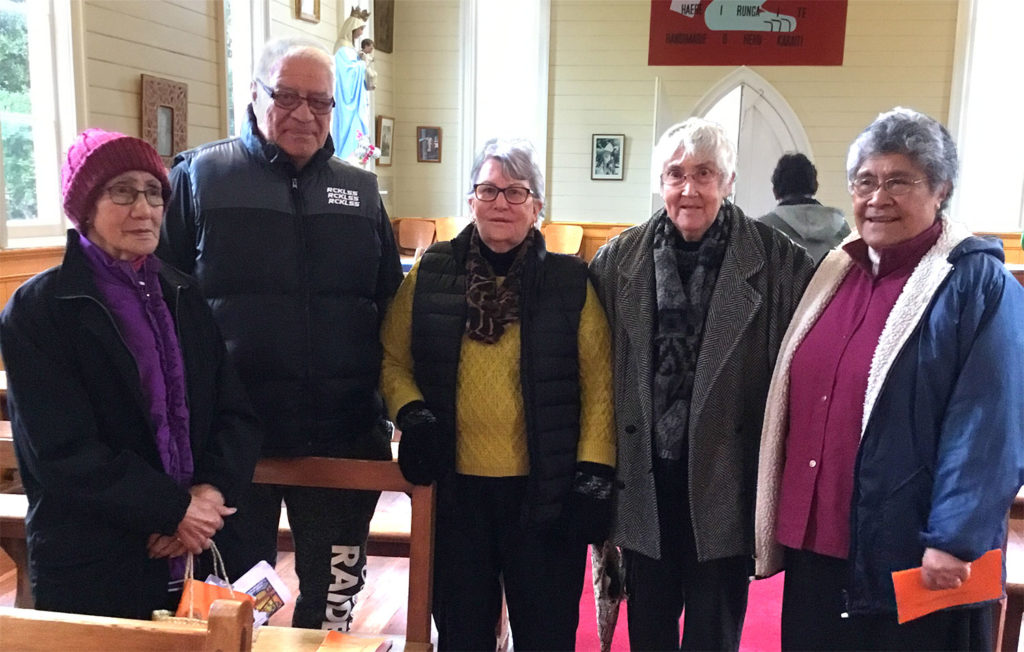WelCom October 2019:

Ngā Tangata o te Awa Tupua
We continue with personal stories from some of the ‘People of the River’ who have longstanding connections with the Catholic Church the Whanganui River. Ka rere tonu ngā kōrero motuhenga mō ētehi o ngā ‘Tāngata o te Awa’ e hono roa nei, e pūmau nei ki te Hāhi Katorika i te Awa o Whanganui.
For Ron Hough and his extended whānau, Hiruhārama is home

Photo: Supplied
I was brought up by my grandparents Toro and Alice Poutini and have lived the greater part of my life here. Our family commuted from here to Ohakune quite a lot. I lived in Ohakune in the late 1950s and went to school at St Joseph’s Convent School. I remember Sr Noelene and Sr John Bosco. Koro then put me through school at Feilding Agriculture so I could learn about farming.
I lived in Waitara for 10 years with my other Koro and Nan Taitoko and Ngati Tawhiri. I came back to Hiruhārama in 1985. During this time, the Access and Maccess courses were being set up by the Labour Department. Being a builder, I decided to do a building course and we built the toilet block, and we did a lot of maintenance work on the marae. Most of the marae of the River had training courses of one sort or another.
Then there was the revitalisation of Te Reo and 1989 we built the Kohanga Reo. Aunty Julie Ranginui set it up and it was run under the direction of the Aotea Kohanga Reo Trust. Lots of things were happening. It was a busy time with so much activity going on. Fr Te Awhitu was living here at the time in the old presbytery. He returned to his home kainga in the late 1980s. Sr Dorothea and Sr Phillipine were also living here in the Convent, going up and down the River, doing their thing. We were very sad when Sr Christina died last year.
About 1986-87 Uncle Tawi who was part of the marae committee decided it was time to pass over the taonga of looking after the marae protocols to me and cousin Thomas Wallace. We didn’t know very much. We were not ready for such a task, but some of the old people, Rody McGregor, Bandy Marshal, Winiata Tapa and Pestle and Ma Pauro, were very encouraging. It was a steep learning curve. It’s only now, that I feel at home in the role of Kaikorero.
Zena my daughter is now the caretaker-manager for the Convent and I am a kaumatua-kaikorero when manuhiri visit the marae. Most of our old people had a close relationship with the Sisters. They were an important part of their lives. Our marae is tied up very closely with the Church, going back to the late 1880s with Mother Aubert and Chief Taiwhati and then Fr Lampila.
Now that I am older, I see things in a different light. I have a new appreciation of the Faith and my place in it. It’s taken me a while to realise this, but I feel I have something worthwhile to pass on to my children and my mokopuna. I’m going to do as much as I can to help them appreciate the Faith much earlier than I did. The Wairua has had a huge effect on my life and I have accepted the role that has been placed on me. We have Mass on the last Sunday of the month and we go as a family. We are learning a little bit more every time. We are in a good space.
Like the other marae on the River, we have been open to different churches at different times. The Salvation Army also had a very strong ministry on the River, a little after Mother Aubert arrived, around 1890s. Our tupuna Tamatea Minahera, who was grandfather to Koro Rawhiti, was a Salvationist. I have read some of his writings. In the early 1990s five Salvation Army people stayed with us. They came to return Tamatea’s bibles back to the family. This was an important time for the Minahera whānau and for all of us who belong here.
Otukopiri-Koriniti – Ngati Pamoana

Lois Gilbert, a respected kuia pakeha, has lived most of her married life in Otukopiri, the original name of Koriniti. A warm and knowledgeable person, Lois has a great love for her husband’s people and has become one of the locals. She has an encyclopaedic knowledge of the area and has vivid memories of the important happenings on the River during her time.
Once on the higher grounds of Operiki, Otukopiri marae, renamed by Richard Taylor as Koriniti or Corinth, is now situated on the lower river flats in a beautiful picturesque setting, with Te Waiherehere and Poutama, ngā whare tupuna and Pepara, the Anglican Church House, taking pride of place. The name Waiherehere takes its name from the ‘combining of many streams flowing out to sea as one’, an image that refers to the uniting of both Māori and Pakeha, ‘walking side by side together into the future’, each with its own inherent strengths and characteristics. Otukopiri is the hearth-place of Ngati Pamoana, where its members often return to wananga, huihui and to bury their dead as well as to find solace, inspiration and peace.
Lois Gilbert Okukopiro
I was married in 1959 at St Paul’s Anglican Church, Putiki, Whanganui to Nu Kingi Gilbert. Aunty Wai Waitere of the Putiki Ladies Guild gave me away. My husband was adopted by Rangi and Kaewa Pokiha. Kaewa was a Metekingi. I have memories of the Rev Keith Elliot VC, who would pick up people in his van – which we called the ‘heavenly taxi’ – and bring them to the church because the church and the marae were the focal point of the community.
In the early years of our marriage we lived in Whanganui and came to live here permanently in the 1980s. We had spent a lot of time here when my first child, Te Kimita, was a baby. We loved coming up for the school holidays. A few of our River marae had their own schools in those days. The Koriniti Pamoana Native School closed in 1969 due to the families moving away to seek employment. My father-in-law, Rangi Pokiha, was a highly-respected rangatira of the River and throughout the whole country. He was a very spiritual man and very much loved.
As long as I can remember, Otukopiri has had a strong Anglican background. Sr Elsie Smith, an Anglican nursing missionary, spent nearly 20 years among us. She worked tirelessly at Otukopiri and at Parikino School and along the river for nearly 40 years. She was godmother to my husband Nu. She looked after him when he was sick and nursed him to full health. She had a dispensary at the back of the mission house where she made medicines for things like the common cold. We had a lot of respect for her. When she left in 1964 a big crowd gathered in her honour. She sent me a photo of her home called ‘The Croft’ that ‘would be waiting for you’. In 1987 I travel to Buckinghamshire, England, to the cemetery where she is buried. We will never forget her and the wonderful work she did among our people, particularly here in Otukopiri.
My father-in-law, Rangi Pokiha, opened up the marae to the different churches when Sr Elsie left. He invited the Salvation Army Church here and they held a wananga run by Wayne Moses. The 7th Day Adventist Church also accepted an invitation to bring their particular brand of the Gospel. These events were one-off. We have been an ecumenical marae, as the Christian message as a lot in common with Māoritanga.
I remember Sonny Haupapa who came here with a strong healing ministry. People took up their bibles. The place would be packed. In those days people were baptised in the Whanganui River, which reminded me of Jesus being baptised in the River Jordan. Sonny was a powerful preacher. He was very popular up and down the River.
The Ringatu Church also has a strong presence here. Some years ago, a call went out to people from Teteko to help revitalise the church. In the early days things were strict. Once you went into the whare, there was no going in and out. I attended a few ra where long karakia would be recited. Another group of Ringatu followers established themselves at Otoko Marae and are still active today.
At the moment we do not have any church services on the marae on a regular basis, which is a shame because Sunday services brought people together. I attend Catholic Mass at Ranana and Hiruharama every month, which brings the people in the immediate vicinity together. A priest comes from Whanganui. Our regular service is a community event where we come together, catch up with each other, share news and pray together and for each other’s families. In a small community such as ours, events like this are important. It helps us stay connected.